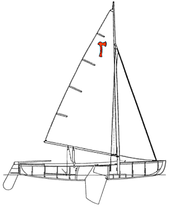Sword boat
As dinghies are called sail boats or sailing ships a flat underwater hull have and where to reduce drift in Halbwind- or close-hauled course of the lateral plane moving through the use of swords is increased.

Sword boats have dimensionally stable hulls . Their righting torque is not achieved by a ballast keel , as is the case with keel boats , but by shaping the cross-section of the hull accordingly. Sword boats are generally relatively wide. The mast height and the sail area driven are lower in relation to the hull size than with keel boats. Sword boats have a very high righting moment when they are slightly heeled (tilt) due to their dimensional stability. However, this righting moment decreases sharply with increasing heel, so that capsizing can occur. With keel boats it is the other way around, with a slight heel the righting moment is low and increases with increasing heel, so that they can hardly capsize or straighten up again after a capsize.
Modern sword boats are now equipped with middle swords. The sword is held in a sword case. This construction method was invented in the USA in 1815, but did not gain acceptance in Germany until after 1875.
Before that, side swords were used for shallow sailing ships , as they are still used today on traditional Dutch flat-bottomed ships . Such ships could thus also in shallow water districts - for example, shallow coastal waters , lagoons , lakes and rivers - sailing . These swords are now operated using a winch .
Lateral swords are primarily lowered on close-hauled or half-wind courses on the leeward side, the side of the ship that is deeper submerged due to the heel, while the sword remains retracted on the windward side. During a turning maneuver, windward and leeward sides change, so that one sword is lowered and the other is retracted.
In the first half of the 19th century, the leeboards were widespread in the North and Baltic Seas, for example the Zeesen boats of the Pomeranian Bodden waters or the Ewer of the Frisians were equipped with them. Lateral swords were also used outside of Europe, some Chinese junks are still driven with swords to this day.
The dinghies and dinghy cruisers , certain cutter types and Zeesen boats belong to the sword boats with a middle sword . The flat bottom ship types Ewer and Tjalk are sword boats with leeboards. Sailed folding boats also have outboard leeboards . However, dinghies can also be equipped with two swords. These are carried in two sword boxes on the board sides within the boat hull. Because each of these sword boxes holds the respective sword in the position of the chimney , such boats are called chimney swords or chimney sword boats .
In the case of narrow swordboats, the righting moment, which decreases with increasing heel, is compensated for by weight trimming by the boat crew.
The keel boats occupy a special position . They are actually to be counted among the keel boats. However, they have a retractable sword combined with a fin keel . The fin keel part is shorter towards the bottom (stubby keel) than in comparable ship designs. It largely ensures the weight stability of the trunk. When lowered, the sword protrudes over this stub keel and thus optimizes the lateral plan .
Certain courses in shallow water can also be sailed with the sword raised.

